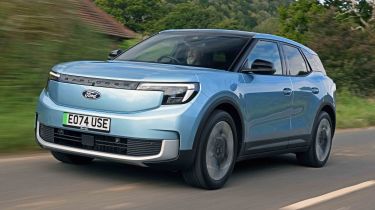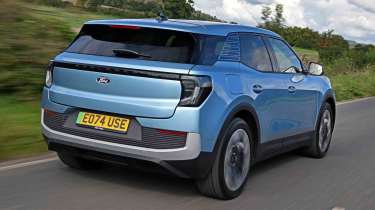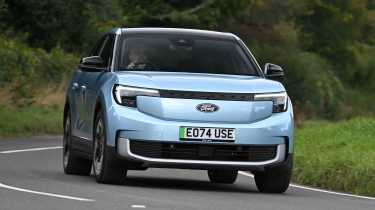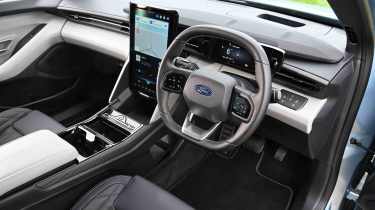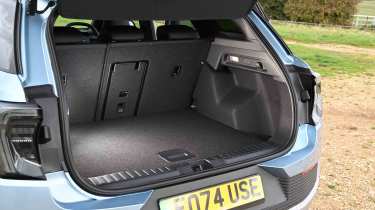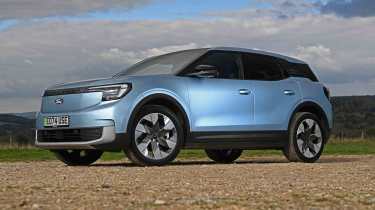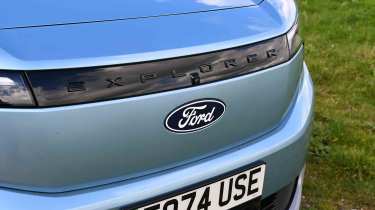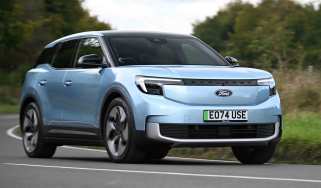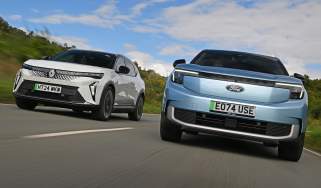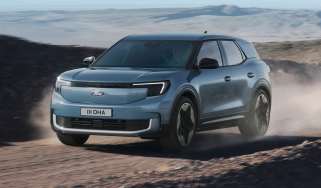Ford Explorer review
Electric SUV has striking, chunky looks and appeal that’s more than skin deep

Is the Ford Explorer a good car?
After the Ford Mustang Mach-E and before the Ford Capri, there came the Ford Explorer. And of these three models that use names from Ford’s back catalogue, the Explorer is probably the one that will cause the least amount of controversy with Ford fans. There’s no real history of Explorer in the UK – the US SUV was more famous for being in Jurassic Park than in regional Ford dealerships – and since the new all-electric model is another SUV, it’s just a variation on an existing theme.
Under the skin of the Explorer is the MEB platform created by the Volkswagen Group and used by Ford to fast-track its expansion into the world of EVs. Overall we’d say that the Explorer is one of the better models to use the MEB underpinnings – we’d certainly choose one over a Volkswagen ID.4 or Volkswagen ID.5.
Trying to stand out in this busy electric compact SUV market is no easy task, but the Ford Explorer manages it. The smooth front and rear ends, squared-off lines and small windows combine to give it a purposeful look.
The range is simple at the moment, with Select and Premium trims on offer, and only minimal differences in specification between them. There are three battery options: the Standard Range has a 52kWh pack, while the Extended Range features a 77kWh unit, while the four-wheel-drive version comes with a 79kWh battery.
| Key specs | |
| Fuel type | Electric |
| Body style | SUV |
| Powertrain | 52kWh Standard Range rear-wheel drive 77kWh Extended Range rear-wheel drive 79kWh Extended Range four-wheel drive |
| Safety | Five stars (Euro NCAP, 2024) |
| Warranty | 3yrs/60,000 miles (manufacturer), 8yrs/100,000 miles (Battery and electric motor) |
How much does the Ford Explorer cost?
There’s a starting price of just under £40,000 for the entry-level Ford Explorer. This Standard Range model in Select trim comes with a 52kWh battery and an official range of 233 miles. Premium trim is also available with the 52kWh pack for £4,000 extra, but this has a shorter range of only 221 miles.
Used - available now

2025 Ford
Explorer
AutomaticElectric
Cash £51,800The 77kWh Extended Range model is around £6,000 extra and has 374 miles of range in Select trim. Upgrading to Premium spec is £4,000 again and this version comes with a range of 354 miles, thanks to the extra weight of the additional kit on board and larger wheels.
Four-wheel drive is available on the top-spec model for a list price of around £54,000. This comes with a 79kWh battery and a twin-motor set-up, while the official range is 329 miles. These prices put the Explorer at the upper end of the compact electric SUV spectrum, although even Select trim has a decent amount of kit.
Standard equipment includes 19-inch alloy wheels, LED lights front and rear, heated front seats, an electrically adjustable driver’s seat and the movable 14.6-inch portrait touchscreen. The step up to Premium trim adds larger 20-inch alloys, matrix-LED headlights, a powered tailgate with hands-free operation, a panoramic glass roof and a B&O sound system, although we don’t think you’ll feel short-changed if you stick with the lower-spec model.
Electric motors, performance & drive
The Ford Explorer uses Volkswagen’s MEB electric car platform, so there are rear or four-wheel-drive configurations to choose from. The smallest and lightest model has a 52kWh battery (Ford quotes the usable capacity for its packs in its brochures) plus 168bhp and 310Nm of torque.
The 77kWh version comes with 282bhp and 545Nm of torque, while the four-wheel-drive model bumps the pack up to 79kWh, but power also increases to 335bhp and 679Nm of torque.
One of the few clues to the Explorer’s VW-derived tech inside is the drive selector. As with other MEB models, there’s a chunky column shifter to the right of the steering wheel, while there are D and B drive modes, with the latter offering stronger energy recuperation to help top up the battery when decelerating. There’s no one-pedal setting, but adjusting the throttle in B mode means you’ll only really use the brake pedal when you need to come to a complete stop.
| Model | Power | 0-62mph | Top speed |
| Ford Explorer Standard Range Select RWD | 168bhp | 8.7 seconds | 99mph |
| Ford Explorer Extended Range Select RWD | 282bhp | 6.4 seconds | 112mph |
| Ford Explorer Extended Range Premium AWD | 335bhp | 5.3 seconds | 112mph |
What is the Ford Explorer like to drive?
While the Explorer uses VW-derived running gear, Ford has been careful to give the car its own character within the electric SUV sector. Although that can be difficult to achieve, it has succeeded, and the Explorer delivers a better driving experience than similar models that also use the same MEB platform.
In town
Some compact SUVs don’t have a tall driving position, but the Explorer features a high-set driver’s seat, so there’s a good view of your surroundings. There’s good visibility, too, helped in part by the novel C-pillars, which have a graphic on the outside, but are clear when viewed from the inside.
Front and rear parking sensors and a reversing camera are fitted, while a light steering wheel and well judged throttle response help with low-speed manoeuvres. From the lights the Explorer pulls away briskly as power is sent to the rear wheels.
There’s a slightly unsettled ride when the car is fitted with 20-inch wheels – the Select model with 19-inch rims does better in this regard, but not by a huge amount.
On A and B-roads
A healthy spread of torque means it’s easy to get up to speed in the Ford and overtaking is simple, too, while the ride improves the faster you go. There’s a soft edge to the handling, so there’s some body roll, but the car never feels unstable or wayward, while the steering reacts quickly to inputs without making the SUV feel nervous.
Overall the Explorer is a more pleasant and enjoyable car to drive than a VW ID.4, although it doesn’t quite capture the same sense of driving fun that other Fords have managed in the past. That can largely be put down to the car’s kerbweight.
On the motorway
At higher speeds, the Explorer delivers great cruising comfort, with minimal road or wind noise, while the ride is at its best here, too, with a level of comfort that is better than that found in a VW ID.4. The B drive mode is best turned off at higher speeds, because it makes the throttle response jerky – D mode is far smoother.
0-62 acceleration and top speed
The 52kWh version of the Ford Explorer has a 0-62mph time of 8.7 seconds and a top speed limited to 99mph. This model is rear-wheel drive, and so is the 77kWh model, although the extra power on tap means it can accelerate from 0-62mph in 6.4 seconds – so it’s not the fastest electric SUV around, but will be fast enough for most people.
The more powerful four-wheel-drive model has to carry the extra weight of the larger battery, but the car’s traction and power boosts mean 0-62mph takes 5.3 seconds. All of the big-battery models have a top speed that’s electronically limited to 112mph.
Range, charging & running costs
Clever exterior design means that while the boxy-looking Explorer doesn’t seem aerodynamic, it’s actually reasonably efficient when compared with rivals.
During our time with an Explorer in Premium trim, we saw the trip computer return an average efficiency of 3.7 miles per kWh, even with some fast motorway use. This translates into a range of 277 miles for the 77kWh model, which will likely be enough for most driving needs.
Electric range, battery life and charge time
Ford quotes a maximum combined range of 374 miles for the 77kWh Explorer in base Select trim. Choosing Premium spec knocks 20 miles off that figure, while the 79kWh model with more power and four-wheel drive has a range of 329 miles. The 52kWh Select model has a maximum range of 233 miles, or 221 miles in Premium guise.
One gripe we have is that a heat pump is a pricey upgrade on all models. Considering that some rivals cost less and have one fitted as standard, we’d expect Ford to add it to the standard kit list. It’s a much-needed add-on to help maintain battery range in colder winter months, but costs around £1,000 to include it.
If you’re going to be using DC charging, the company offers different maximum rates depending on which battery is fitted. The 52kWh battery can charge at up to 145kW, while the 77kWh battery has a lower rate of 135kW. Neither maximum is particularly outstanding these days, and means charging from 10-80 per cent capacity takes 25 minutes and 28 minutes, respectively. The 79kWh pack has an even higher maximum top-up rate, at 185kW, although a 10-80 per cent charge only takes two minutes less than for the 77kWh battery, at 26 minutes.
| Model | Battery size | Range | Insurance group |
| Explorer Standard Range Select RWD | 52kWh | 233 miles | 20 |
| Explorer Extended Range Select RWD | 77kWh | 374 miles | 29 |
| Explorer Extended Range Premium AWD | 79kWh | 329 miles | 33 |
Tax
With all EVs sitting in the lowest company-car tax bracket, the Benefit-in-Kind costs all boil down to list price. Since the Explorer is pricier than some rivals, it’ll cost business users more money each year, but we’re only talking a few pounds rather than the hundreds you’d have to shell out for a combustion-engined car.
Insurance groups
Ratings go from Group 19 for Select trim with the smallest battery, all the way to Group 32 for the Premium in 335bhp guise. These categories are in line with most electric SUV rivals, although compared with the combustion-engined Ford Kuga SUV, they are higher overall.
Depreciation
Depending on specification, the Explorer is expected to hold on to 50 to 54 per cent of its original value after three years and 36,000 miles. In comparison, the new Capri has predicted values that are a percentage point higher than that, but both are well ahead of the Mustang Mach-E, which is in the 40 per cent range.
Interior, design & technology
There are some VW-sourced parts in the Explorer’s cabin – the most obvious being the driver’s display with drive selector, the touch panel for controlling the lights and the keyfob – but overall Ford has made the Explorer’s cabin its own.
What is the Ford Explorer like inside?
Considering Ford had some fixed parameters to work with when creating the Explorer, it’s not obvious from the cabin that its tech and running gear is shared with any VW models. One big factor in that is the cabin layout, which has a large central tunnel separating the front seats – by comparison, the VW ID.4 has a more open feel up front. Of course, the other big difference is the addition of Ford’s vast 14.6-inch portrait touchscreen.
What is the interior quality like?
That display is one place where the cabin finish takes a bit of a backward step, because the mechanism for the sliding screen leaves exposed edges that spoil the appearance of the centre console when the display is vertical. But overall the cabin feels well constructed and features plenty of decent, high-quality materials.
Sat-nav, stereo and infotainment
With so much tech on offer, it’s no surprise that the majority of the Explorer’s functions are controlled via the portrait screen. The Ford’s vast 14.6-inch touchscreen is so large that the climate controls at its base only take up a fifth of the display, but they’re still harder to use than conventional buttons. The screen has plenty of room for big buttons to select different sub-menus and these are easy to locate when you’re on the move.
A carry-over from VW is the touch-sensitive volume slider, which needs a firm press to activate. The volume can be adjusted via the steering wheel, too, although this slider is inconsistent in its responses.
The long piece of trim across the top of the dashboard is actually a sound bar, and is similar in concept to the home audio device. Premium models have a great-sounding Bang & Olufsen set-up, but the Select comes with an unbranded system that still offers decent quality.
Ford’s SYNC Move software is responsive and offers quick loading times, while voice control is available if you’d rather not use the screen. A row of shortcut buttons across the top of the screen allows quick access to important functions, and there’s a Home button lower down that gets you back to the main screen, if needed.
Boot space, comfort & practicality
Ford’s designers have given the Explorer a distinctive look with its smooth nose and matching rear end. It’s a clean-sheet design that doesn’t refer back to any past models, while the car’s wide stance and squared-off shape helps it fit the SUV brief. A long wheelbase and wide track help the Explorer to deliver decent passenger space, but the boot could be better.
The windows look like they’re on the small side, but there’s some clever tech going on with them to help boost all-round visibility and the sense of space inside. The mirror-finished graphic on the external C-pillars is etched into the glass and looks transparent from within the cabin.
| Dimensions | |
| Length | 4,468mm |
| Width | 1,871mm (2,063mm inc mirrors) |
| Height | 1,630mm |
| Number of seats | 5 |
| Boot space | 470-1,460 (RWD Select), 445-1,417 litres (AWD Premium) |
Dimensions and size
The Explorer is one of the wider cars in the class, while the wheelbase is long enough to deliver as much space inside as the class best. A Renault Scenic E-Tech has proportions that largely match, while the Volkswagen ID.4 and Volkswagen ID.5 are (unsurprisingly) similar in size.
If you want more boot space, then the Ford Capri has a longer tail with 572 litres of space in five-seat mode, which is 122 litres more than the Explorer has to offer.
How practical is the Ford Explorer?
Seats & space in the front
Comfortable seats and a mix of different-coloured materials help the cabin to feel airy, while storage is excellent.
There are the usual door bins (with dividers to stop loose items sliding up and down) and a decent glovebox, but the centre console bin is simply vast. Ford calls it the Mega Console, and it’s possible to remove the cup-holders located ahead of the central armrest to create up to 17 litres of space – big enough to fit a laptop or a couple of 1.5-litre drinks bottles. There’s a handy slot ahead of the Mega Console under the main display to store the cup-holders when they’re not in use.
The Explorer’s display moves from reclined to vertical to help mitigate unwanted screen reflections, but we never really found that to be much of an issue during our time with the car. Moving the screen to a vertical position pushes the lower part of the display further away from the driver, too, which makes it slightly harder to use, but this also reveals the hidden storage compartment behind it.
There’s room for a couple of smartphones and twin USB-C sockets for charging, while the space is locked with the rest of the car when left.
Seats & space in the back
A wide body means there’s plenty of elbow room in the back of the Explorer, so seating three abreast shouldn’t cause any grumbles. The seat base is on the short side, though, and when combined with a high-set floor, it means under-thigh support is in short supply, which could be uncomfortable for taller occupants on longer trips. At least the flat floor means there’s foot space across the floor for all three occupants. Plastic tabs cover the two sets of ISOFIX mounts in the back, so fitting a child seat will be simple.
Headroom is good, even with the panoramic glass that’s fitted to Premium models. There’s no sun blind, just reflective glass, which also helps to reduce weight.
Boot space
A low lip with a level floor helps with loading, but a boot capacity of 470 litres (445 litres in AWD Premium form) is adequate when compared with rivals. The back seats fold flat in a 60:40 split, providing 1,460 litres (1,417 litres in AWD Premium form) of space in this configuration. Some storage space is provided beneath the boot floor, but it is only big enough for charging cables. Unlike some rivals, Ford hasn’t included any storage under the Explorer’s bonnet.
Towing
If you want to use the Explorer to haul a trailer, Ford offers a towbar on the accessories list. The towing capacity is 1,000kg for the RWD model and up to 1,200kg for the AWD version.
Reliability & safety
A five-star Euro NCAP rating should offer peace of mind, although if you’d prefer to deactivate some of the electronic driver aids, this involves entering sub-menus on the central touchscreen. There is a shortcut in the top right for the main driver-assistance menu, but it’s still fiddly when compared with a simple button press, and you’ll need to do this every time you start the car, too.
Various electronic sensors help to keep the Explorer on the straight and narrow, with lane assistance and forward-traffic detection able to adjust the car’s position and speed without any input from the driver. Even the compulsory speed-limit warning isn’t as intrusive as some systems, courtesy of the gentle chime that Ford has equipped it with. However, if you’d rather not use these systems at all, you can deactivate them via a menu that’s a couple of button presses away from the main touchscreen.
Standard safety equipment is good, with both trim levels getting lane-keep aid, adaptive cruise control, traffic sign recognition and cross-traffic and exit warning systems. But it is a shame that the only options package is the one for driver assistance, which for almost £2,000 (£500 less on the higher Premium trim level as you already get the powered tailgate that’s part of the pack) adds a head-up display, lane centring with lane-change assist, active park assist and a 360-degree camera.
The platform for the ID.4 has been around for a few years, so any issues will hopefully have been ironed out. We hope that Ford is working to improve upon its disappointing score of 30th place out of 32 manufacturers in the best brands category of the 2024 Driver Power customer satisfaction survey - one position below Volkswagen in 29th position.
| Key standard safety features | Euro NCAP safety ratings |
|
Warranty
A basic three-year/60,000-mile warranty is standard, and there’s only 12 months of roadside assistance, too. The Explorer’s drive battery is covered for eight years/100k miles.
Servicing
Ford is offering five years of complimentary servicing with the Explorer to retail buyers, and it also includes roadside assistance for the same period. That should give added peace of mind, while long two-year/unlimited-mileage service intervals demonstrate the low-maintenance nature of EVs such as the Explorer.
Ford Explorer alternatives
The most obvious rivals for the Ford Explorer are the platform-sharing Volkswagen ID.4 and ID.5, plus the Skoda Enyaq. There’s also the Ford Capri, which has a different shape that offers a bit more space, but costs a couple of thousand pounds more. Elsewhere, the Renault Scenic E-Tech offers good value, while other options in a similar price band include the Hyundai Ioniq 5, Kia EV6, all-electric MINI Countryman and Toyota bZ4X.
Frequently Asked Questions
Ford offers a three-year/60,000-mile warranty on the Explorer, whichever comes first. This is about as basic as you get on any car, but because it’s an EV, the electric powertrain components get an eight-year/100,000-mile warranty, guaranteeing the battery will still have at least 70 per cent of its original capacity during that period.

